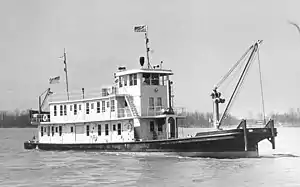Sycamore-class buoy tender
The Sycamore class were three river buoy tenders of the United States Coast Guard, commissioned in 1941 and 1943. Primarily designed to maintain navigational aids, they also conducted flood relief, search and rescue, and law enforcement operations, as well as pleasure boat safety inspections.
 USCGC Forsythia | |
| Class overview | |
|---|---|
| Builders: |
|
| Operators: |
|
| Cost: | $159,000 each |
| Built: | 1941–1943 |
| In commission: | 1941–1989 |
| Completed: | 3 |
| Retired: | 3 |
| General characteristics [1][2][3] | |
| Type: | Buoy tender |
| Displacement: |
|
| Length: |
|
| Beam: | 26 ft (7.9 m) |
| Draft: |
|
| Propulsion: |
|
| Speed: |
|
| Complement: |
|
| Armament: | Small arms |
Ships
| Name | Commissioned | Decommissioned |
|---|---|---|
| Sycamore (WAGL-268) | 9 September 1941 | 30 June 1977 |
| Dogwood (WAGL-259) | 17 September 1941 | 11 August 1989 |
| Forsythia (WAGL-63) | 15 February 1943 | 12 August 1977 |
References
- "Sycamore, 1941". U.S. Coast Guard Cutter History. 2012. Retrieved 6 July 2012.
- "Dogwood, 1941". U.S. Coast Guard Cutter History. 2012. Retrieved 6 July 2012.
- "Forsythia, 1943" (PDF). U.S. Coast Guard Cutter History. 2012. Retrieved 6 July 2012.
This article is issued from Wikipedia. The text is licensed under Creative Commons - Attribution - Sharealike. Additional terms may apply for the media files.